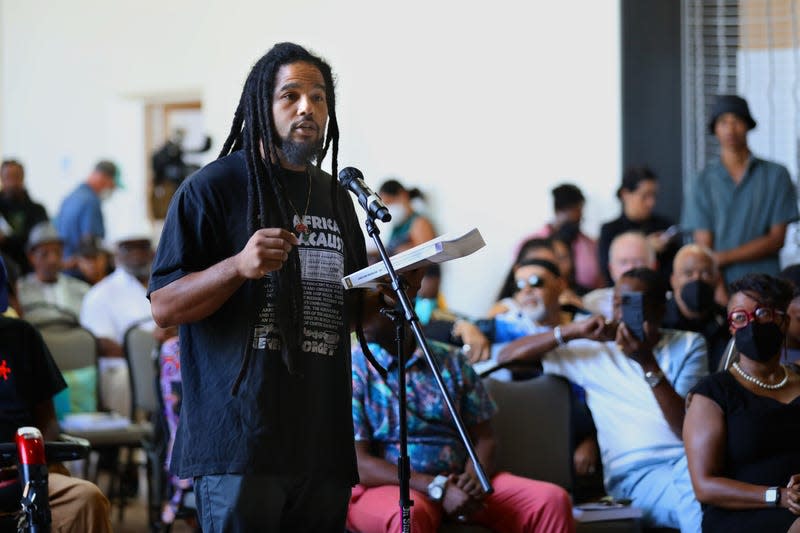Are Reparations A Possibility? We Asked The Experts

The fight for reparations for formerly enslaved people in the United States has been brewing for centuries. But in recent years, the push to provide reparations to Black Americans has been heating up. In California, lawmakers are moving ahead with the most comprehensive reparations plan yet. And on Capitol Hill, lawmakers like Representative Cori Bush are pushing for massive national reparations plans.
But just how realistic are these efforts, and where should people who want reparations focus their energy? The Root sat down with experts to try to find out.
Read more
Aside from Halle Bailey, Here Are Other Black Disney Actors and Characters We Love
Megan Thee Stallion Becomes 1st Black Woman to Land Forbes 30 Under 30 Cover
15 Priceless Black Twitter Moments Worth Remembering [Updated]
Folks who are deeply into the fight for reparations may already know this name. Dr. William Darity, an Economist, and Duke University Professor, penned From Here to Equality: Reparations for Black Americans in the Twenty-First Century, a book making the case for reparations. And Dr. Darity has a lot to say about the plans for reparations popping up across the country.
“I think that the only effective plan for reparations must be conducted by the federal government,” he says. “piecemeal efforts at the state, local, or individual or private organization level are actually distractions and detours from the central task of getting Congress to pass comprehensive reparations.”
In his book, which he co-wrote with author Kirsten Mullen, they argued that in order to close the wealth gap, Black Americans descended from enslaved people in the United States would need $350,000 per person in reparations. Their plan estimates that it would cost the United States government $14 trillion to accomplish that goal. “The difficulty is that both the state and local governments, as well as private donors, don’t really have the capacity to meet the bill,” explains Darity. “If the minimum bill is $14 trillion, it’s noteworthy that the total budget combined for all state and local governments in the United States is less than $5 trillion.”
Jo Von McCalester, a Political Science Lecturer at Howard University, says she understands Dr. Darity’s concerns that the push for reparations could distract from the larger goal of a national plan. However, she remains more optimistic about the movement in the states. In California, lawmakers are set to vote later this Summer on a comprehensive reparations plan, which includes cash payments to descendants of enslaved African Americans. “It’s major,” says McCalester. “The nation should be paying attention.”
“California is the petri-dish of the nation. That starting place, to spark others in the country to follow,” explains McCalester, referencing policies like same-sex marriage that caught steam after becoming law in California. “I can go down the list of things that have been introduced and gone through an entire process in California and informed the rest of the nation.”
Whether we ever achieve the ambitious goals outlined by folks like Dr. Darity, McCalester says it’s important to remember that the United States has paid reparations to other groups before, such as after World War II following the forced internment of Japanese Americans. She also referenced the fact that Haitians were forced to pay billions of dollars to France for the crime of winning their freedom from their enslavers.
“This isn’t outlandish,” she says. “It’s only outlandish because historically speaking, things have been repeatedly done to people of African descent, to Black people in the United States, and repayment for that behavior has been seen as something that is too much. Even getting an apology for slavery didn’t happen until the 90s.”
How Far Have We Come on Reparations?
Ohio State History Professor Hasan Kwame Jeffries says that progress in places like California has been swift. Back in 2020, the farthest you were going to get was creating a panel, says Jeffries. Now, there are several comprehensive proposals. And in Evanston, Illinois, some residents have begun to receive reparations on a small scale.
But Jeffries says on a larger scale, we’re much more likely to see plans that look different from how we’ve traditionally conceived of reparations.
“We have a higher likelihood of getting programs that are called reparations,” says Jeffries. “As opposed to this kind of direct payments, which is how I think we’ve typically thought about reparations.”
Getting a consensus on what reparations is for and why it’s necessary is massively important, says Jeffries. “It’s been framed on the political right as just a giveaway,” he says. “And so until that changes, until the idea of what reparations changes, then there won’t be a “what will it look like” [conversation] because you won’t even get that far.”
Education is a key component of this fight, says Jeffries. “The case for reparations isn’t made simply on the basis of the horror of slavery, which is absolutely in on and of itself could be made,” he says. “But the issue with the institution of slavery is not just what occurred while slavery was legal, but it’s the legacy of the institution of slavery...the question of discrimination, institutional, legal sanction, discrimination continues for another 100 years in both formal and informal ways.”
Despite some of his concerns about reparations plans on the state level being a distraction, Dr. Darity says that overall, he’s hopeful about the future.
“If you asked me this 30 years ago when I first started working on this, I would have said, well, the odds are pretty slim. If you asked me five years ago, I would have said, yeah, that’s really not likely...but we should put a plan in place,” he says. “Now, if you ask me today, I would say yes, the odds are still long, but the situation looks more optimistic than it ever has in my lifetime.”
More from The Root
Sign up for The Root's Newsletter. For the latest news, Facebook, Twitter and Instagram.

